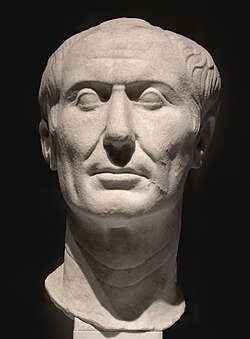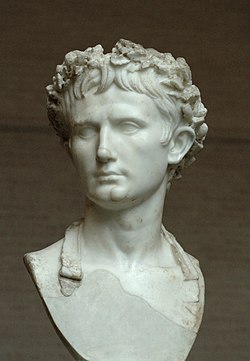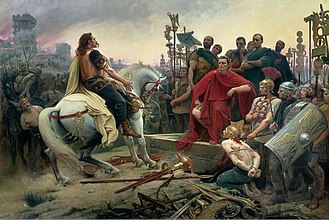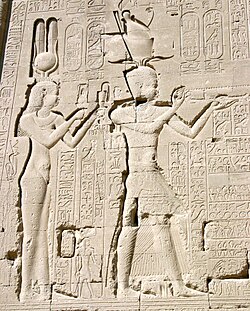Gaius Julius Cäsar
Back
Basic data
-
July 13, 100 BCE in Rom
-
†March 15, 44 BCE in Rom
-
Staatsmann, Feldherr
Documents
Biographical information from the WeGA
No biographical data found
Biography not available due to one of the following causes:
- Data will be added at a later stage
- Research of the WeGA was without success so far
- It is a well known person where enough information is available online elsewhere, see e.g Wikipedia






![Bronze bust of Cato, Caesar's principal opponent in the Catilinarian debate and also a personal enemy. Cato may have been responsible for the law requiring declarations of candidacy in person within the pomerium.[59] (Source: Wikimedia) Bronze bust of Cato, Caesar's principal opponent in the Catilinarian debate and also a personal enemy. Cato may have been responsible for the law requiring declarations of candidacy in person within the pomerium.[59] (Source: Wikimedia)](https://upload.wikimedia.org/wikipedia/commons/thumb/8/8d/Cato_Volubilis_bronze_bust.jpg/250px-Cato_Volubilis_bronze_bust.jpg)





![This mid-1st-century-BC Roman wall painting in Pompeii is probably a depiction of Cleopatra VII as Venus Genetrix, with her son Caesarion as Cupid. Its owner Marcus Fabius Rufus most likely ordered its concealment behind a wall in reaction to the execution of Caesarion on orders of Octavian in 30 BC.[166][167] (Source: Wikimedia) This mid-1st-century-BC Roman wall painting in Pompeii is probably a depiction of Cleopatra VII as Venus Genetrix, with her son Caesarion as Cupid. Its owner Marcus Fabius Rufus most likely ordered its concealment behind a wall in reaction to the execution of Caesarion on orders of Octavian in 30 BC.[166][167] (Source: Wikimedia)](https://upload.wikimedia.org/wikipedia/commons/thumb/d/de/Venus_and_Cupid_from_the_House_of_Marcus_Fabius_Rufus_at_Pompeii%2C_most_likely_a_depiction_of_Cleopatra_VII.jpg/330px-Venus_and_Cupid_from_the_House_of_Marcus_Fabius_Rufus_at_Pompeii%2C_most_likely_a_depiction_of_Cleopatra_VII.jpg)



![This also shows Caesar's laurelled head with the inscription CAESAR DICT PERPETVO. The reverse, however, shows the name of the moneyer – one Publius Sepullius Macer – along with the goddess Venus, with which Caesar identified, holding Victory in her right hand and a sceptre in the left.[216] (Source: Wikimedia) This also shows Caesar's laurelled head with the inscription CAESAR DICT PERPETVO. The reverse, however, shows the name of the moneyer – one Publius Sepullius Macer – along with the goddess Venus, with which Caesar identified, holding Victory in her right hand and a sceptre in the left.[216] (Source: Wikimedia)](https://upload.wikimedia.org/wikipedia/commons/thumb/2/22/Iulius_Caesar_denarius_44_BC_851830.jpg/250px-Iulius_Caesar_denarius_44_BC_851830.jpg)
![Denarius (42 BC) of Cassius and Lentulus Spinther, depicting the crowned head of Liberty and on the reverse a sacrificial jug and lituus[217] (Source: Wikimedia) Denarius (42 BC) of Cassius and Lentulus Spinther, depicting the crowned head of Liberty and on the reverse a sacrificial jug and lituus[217] (Source: Wikimedia)](https://upload.wikimedia.org/wikipedia/commons/thumb/4/4d/Gaius_Cassius_Longinus_and_Lentulus_Spinther._42_BC._AR_Denarius.jpg/250px-Gaius_Cassius_Longinus_and_Lentulus_Spinther._42_BC._AR_Denarius.jpg)

![January-February 44 BC Denarius. Rome mint; portrait of laurelled Julius Caesar right; CAESAR IM[P] Venus standing left, holding Victory in outstretched right hand and transverse scepter in left, resting her left elbow on shield set on celestial globe. (Source: Wikimedia) January-February 44 BC Denarius. Rome mint; portrait of laurelled Julius Caesar right; CAESAR IM[P] Venus standing left, holding Victory in outstretched right hand and transverse scepter in left, resting her left elbow on shield set on celestial globe. (Source: Wikimedia)](https://upload.wikimedia.org/wikipedia/commons/thumb/4/48/Gaius_Julius_Caesar%2C_denarius%2C_44_BC%2C_RRC_480-3.jpg/250px-Gaius_Julius_Caesar%2C_denarius%2C_44_BC%2C_RRC_480-3.jpg)




![Roman painting from the House of Giuseppe II, Pompeii, early 1st century AD, most likely depicting Cleopatra VII, wearing her royal diadem, consuming poison in an act of suicide, while her son Caesarion, also wearing a royal diadem, stands behind her[274] (Source: Wikimedia) Roman painting from the House of Giuseppe II, Pompeii, early 1st century AD, most likely depicting Cleopatra VII, wearing her royal diadem, consuming poison in an act of suicide, while her son Caesarion, also wearing a royal diadem, stands behind her[274] (Source: Wikimedia)](https://upload.wikimedia.org/wikipedia/commons/thumb/7/7b/Roman_Wall_painting_from_the_House_of_Giuseppe_II%2C_Pompeii%2C_1st_century_AD%2C_death_of_Sophonisba%2C_but_more_likely_Cleopatra_VII_of_Egypt_consuming_poison.jpg/250px-Roman_Wall_painting_from_the_House_of_Giuseppe_II%2C_Pompeii%2C_1st_century_AD%2C_death_of_Sophonisba%2C_but_more_likely_Cleopatra_VII_of_Egypt_consuming_poison.jpg)








